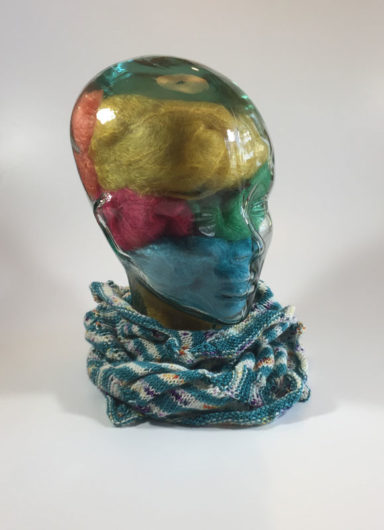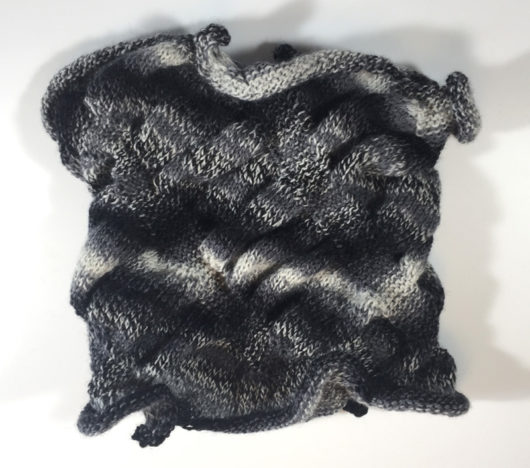This is Taiga Hilliard’s Alana cowl. It’s a very different knit for me. Way more fashion-forward that I’d usually mess with. This is not going to be a warm cowl and I am typically a utilitarian knitter. Oh, I suppose it could take the edge off office air conditioning. But I left the office behind more than 4 years ago. Even though I like this, it’s just not me and I’ll be gifting it to someone. But I haven’t yet figured out who. This was a quick, fun knit.
Another reason why this knit is different for me is that I knit Alana in Anzula Vera, a sport weight fiber mix I’ve never worked with before. It’s 65% silk with the remaining 35% described as “linen/flax.” I’ve never knit with an Anzula yarn that wasn’t a satisfying experience. Vera was deeply discounted. I gave it a try. My reaction to all silks is that it’s a very dry yarn to work with. Borrowing an expression I heard recently from the young plumber who worked on my water softener system, “dry as a popcorn fart.” That’s not a feel my hands like. As I knit I feel as if the yarn’s sucking out all the moisture from my hands. Still, the yarn was uniform, with no knots.
You may be wondering about this stitch pattern. That was a first for me and it’s what drew me to the pattern. I figured it was a dropped stitch pattern, but I had no idea how it was formed. I won’t spill all the beans. It combines an elongated stitch with a dropped stitch. You knit tightly compacted cables all across the rounds of the cowl. Then, on the last round–as you bind off– comes all the magic. With apologies for the color disconnect, that’s when this:
changes into this:
Next up is yet another Wolkig, this time in Sun Valley Fiber, an 80% merino, 10% cashmere goat, 10% nylon fingering weight. It’s Martina Behm’s freebie pattern, available on Ravelry. I’ve knit it seven times and only have one Wolkig in my personal collection. When it comes to my holiday-pick-your-gift gathering this year, I’ll wager that this orange one won’t last long.
I am always pleased with the organic look that the super-simple Wolkig pattern produces. Check here for other Wolkigs I’ve knit. 







































